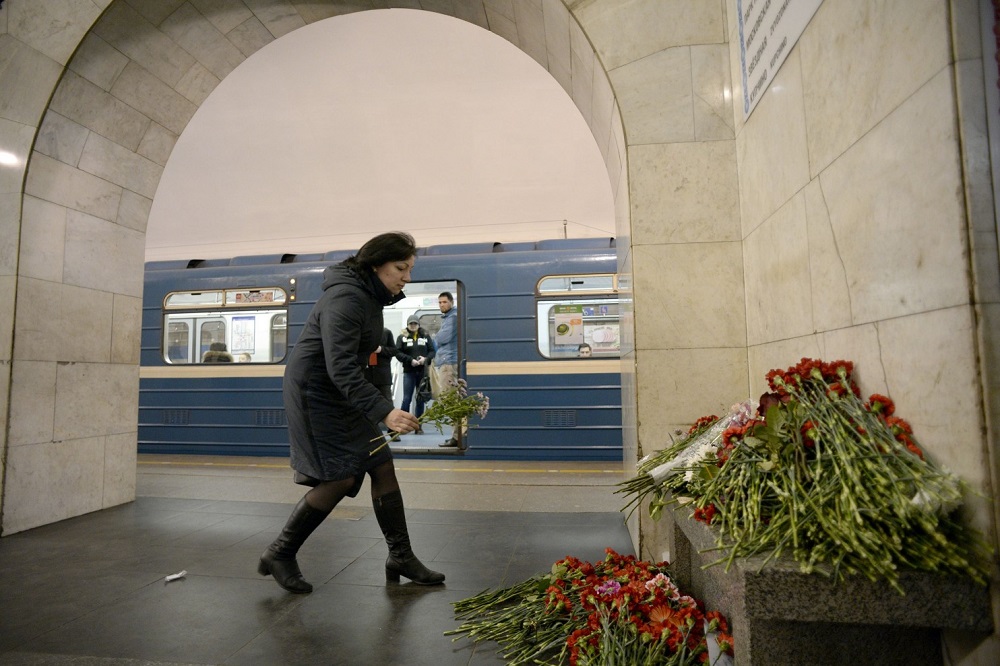St. Petersburg – He was a 22-year-old from the Central Asian republic of Kyrgyzstan. She was a 21-year-old from Azerbaijan. They were part of the modern-day fabric of Russia’s melancholy old imperial city. He was the bomber, police say. She was one of his 14 victims, most of them in their 20s or younger.
Russian investigators on Tuesday identified the man they suspect blew up a subway car here as Akbarzhon Dzhalilov, an ethnic Uzbek and naturalized Russian citizen who had remained in St. Petersburg, working in a sushi place, after his parents returned to Kyrgyzstan. DNA evidence and security camera footage point to his being the perpetrator of Monday’s attack, they said.
At the Mariinsky hospital morgue Tuesday, nearly 100 relatives, classmates, and well-wishers came to bid farewell to Dilbara Aliyeva, 21, whose body was to be sent back to her native Azerbaijan. Some carried Aliyeva’s portrait, of a young dark-haired woman with deep brown eyes and sharp eyebrows.
A teacher, Irina Berezovskaya, held back tears as she described Aliyeva as a quiet psychology student who was close to her family and loved to cook traditional Azeribaijani dishes.
“She was always bright. She was fascinated by what motivated people and was so good at figuring them out. She was writing her dissertation on motivation and sport; her brother is a professional soccer player,” said Berezovskaya, who wore a black scarf over her hair. “It was her brother who finally told my students, ‘We lost Dilbara.’ I looked on the list of those who died and saw someone born in 1996. I had seen her just hours earlier.”
The bombing, at 2:40 in the afternoon, left 60 people injured. Among the 10 dead who have been identified, seven were born since 1990. The youngest was born in 2000.
Officials said Dzhalilov was a member of the Uzbek minority from the city of Osh, which has been the scene of bloody ethnic conflicts and the growth of Islamist militant movements since the Soviet Union began disintegrating three decades ago.
According to both Kyrgyz and Russian media reports, Dzhalilov left Kyrgyzstan for St. Petersburg with his family in 2011, a year after fighting broke out between ethnic Uzbeks and ethnic Kyrgyz in the city where Dzhalilov’s father, who held Russian citizenship, worked at an auto body shop. Dzhalilov worked as a sushi chef in St. Petersburg and occasionally took martial arts courses at a local gym, according to local media.
He had left a second bomb, at another subway station, that failed to detonate, investigators said.
In previous reports, the Investigative Committee had called the attack a suicide bombing. On Tuesday, it did not say whether Dzhalilov had died in the blast.
A page on a Russian social network VKontakte purportedly linked to Dzhalilov showed a young man smoking shisha pipes and lusting after fast cars. One Russian news agency, Rosbalt, said it had called the owner of the page through a telephone number listed online, who denied he was the suicide bomber. The Washington Post called the number listed on the page, which was blocked.
No group has claimed responsibility for the attack, although Russia has been targeted in the past both in connection with an insurgency in the country’s Caucasus region and over Russia’s intervention to support Syrian regime leader Bashar al-Assad.
The attack took place while Russian President Vladimir Putin was in St. Petersburg for talks with the leader of Belarus.
“Undoubtedly, the fact that the terrorist attack was committed while the head of state was in the city forces one to reflect,” Dmitry Peskov, his spokesman, told reporters.
Putin, who has staked his legitimacy on establishing law and order in Russia, has spoken little since the attack, offering only brief comments on Monday, when he promised a full investigation and support for the victims.
At Sennaya Ploshchad, a downtown St. Petersburg landmark, commuters tramped by mounds of flowers, mainly roses and carnations, and burnt out tea lights. Metro service resumed on Tuesday, but the city was still jumpy, and several new bomb threats forced evacuations.
Among the victims was Irina Medyantseva, 50, who sewed handmade dolls, gave them names like Petersburg Angel or Yellow Bunny and sold them online for several hundred dollars each.
The Washington Post
